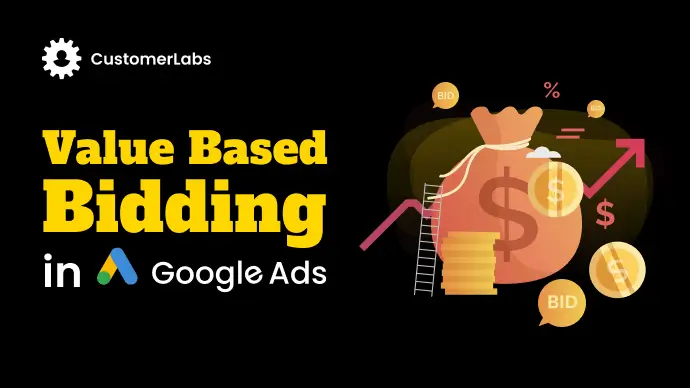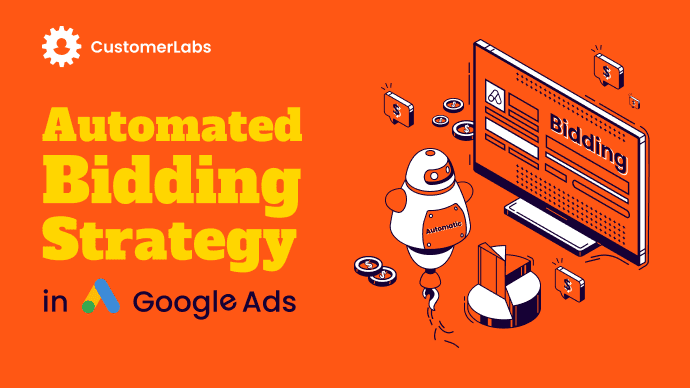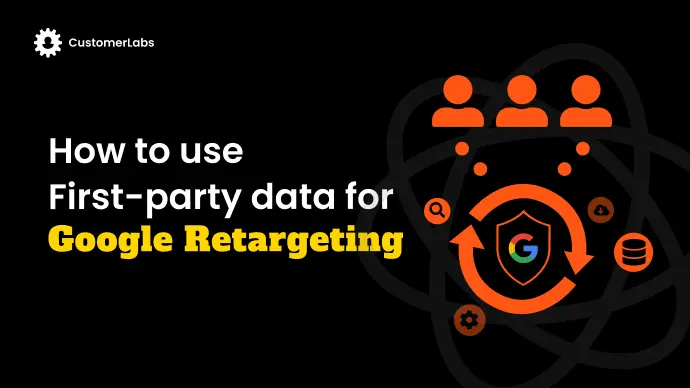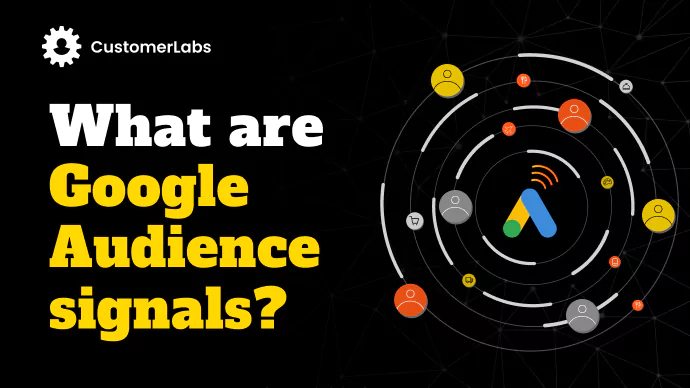
Targeting the right audience with your ad is not an easy task. Multiple factors are involved in making your audience engage with your ad to improve your ad campaign performance. This blog will demystify the art of targeting the right audience using Google audience signals for better reach, and improved ad campaign performance.
The blog tries to explain the below
- What are Google’s audience signals
- Types of Google Audience Signals
- How to set up audience signals in Google Ads
- How you can optimize your ad campaigns using the right audience signals
- Leveraging the Google Ads audience signals for your ad campaign’s performance
So, first things first, let’s start with
Understanding Google Audience Signals
Google audience signals are those intricate cues that help the machine learning algorithm learn better about your target audience. Google audience signals is an important feature that allows users to input traits of the target audience such as interests, intentions, demographics, and behavior to help the algorithm target the users the right ad asset.
Further Google also says “the algorithm uses audience signals to deeply understand your audience’s intent, preferences & context to widen its reach to new audiences”.
If the ad platform finds an audience beyond these signals who exhibit traits of converting into the customer, they will also be targeted.
Therefore, although machine learning & automation are driven by audience signals, other parameters guide the ad platform to expand your ad reach to achieve the required goal.
Audience signals primarily come from your first-party data among all other sources.
The ad platform uses these audience signals & the data to learn about the kind of audiences that are more likely to convert. The ad platform also analyzes the users’ search history and website activity to gather more audience signals. It will then target the right audience using various factors like age, gender, location, and interests.
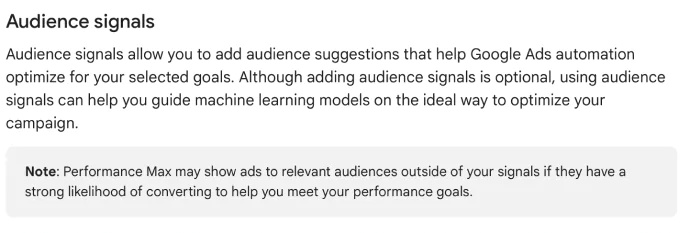
Types of Google Audience Signals
The ad platform’s algorithm uses the below audience signals to target the right audience:
- Age
- Gender
- Location
- Interface Language
- Income
- Affinity audiences
- In-market audiences
- Custom intent audiences
- Purchase intention of the user
- Device
- Browser
- Operating System
- Actual query by the user
- Ad creative
- The interest of the user
- Time of the day or day of the week
- Your data (remarketing audience – website/app visitors)
- RLSA
- Customer Match List
- Similar audience (Similar audience feature is no more available from May 1, 2023)
- Search network partner
- App ratings & reviews
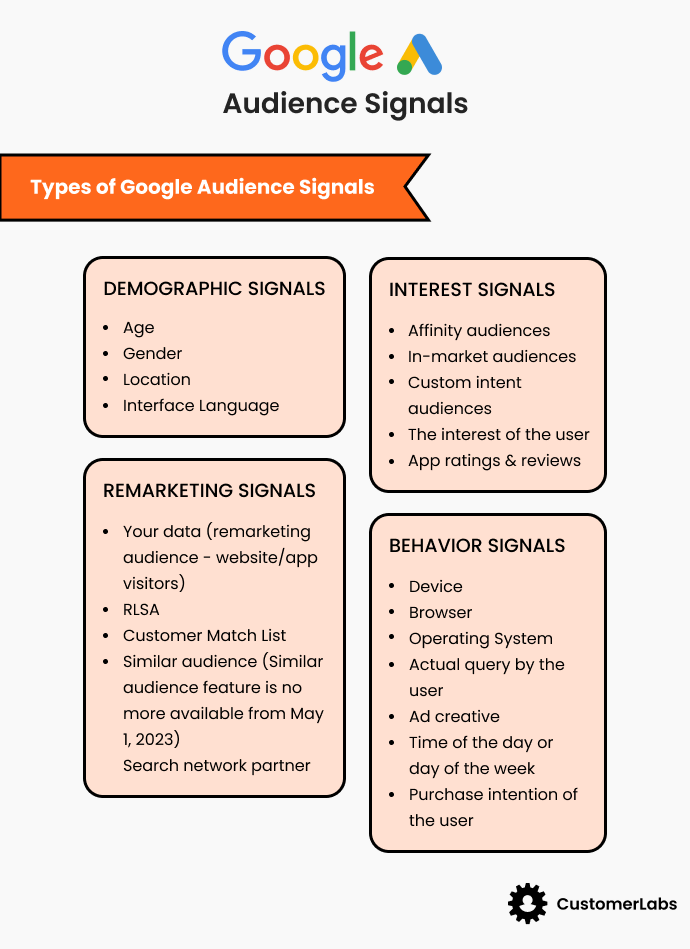
Your data, i.e., the first-party data provides most of the above audience signals. Some of them are device ID, browser ID, OS, location, search query made on your website, user behavior & actions like on which product the user has shown interest, if the user has browsed multiple products, or added any products to the cart, and many more.
The above audience signals are sent through ‘your data’. Apart from the first-party data, there are several other segments through which Google gets audience signals.
There are 7 kinds of audiences in Google Ads
- Your data segment (earlier remarketing list)
- Affinity segment (earlier affinity audience)
- In-market segment (earlier in-market audience)
- Similar segment (earlier similar audiences)
- Detailed demographic segment (earlier Detailed demographics (audience))
- Custom segment (earlier custom audience)
- Life-event segment (earlier life-event audience)
Leveraging Google Audience Signals for Targeting the Right Audience
Google audience signals provide huge information about the target audience to Google Ads. With the right expertise and understanding, tweak & train the ad algorithm, to benefit from the audience signals.
With manual bidding, it is possible to leverage only individual audience signals.

With limited signals, the ad platform is directed only to a certain extent. The ability to expand the reach to more audiences is also limited. If an attempt is made to increase the ad reach for more conversions with manual bidding, the result is decreased ROI.
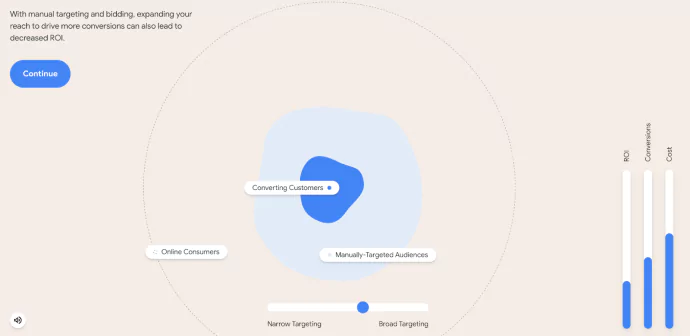
This is because the ad campaigns have hit the point of diminishing returns. That means even when there is an increase in the budgets, the ad campaigns do not scale. This is due to lack of proper signals and data. All this will lead to higher costs and lesser conversions.
Automated bidding strategies combined with the right first-party data strategies will help the ad platform analyze numerous real-time signals such as user’s intent, preferences, context, and various other cross-signal effects.
Now with automation, data, and audience signals the ad platform will bid to reach the goal. The goal can be to maximize conversions or maximize conversion value or achieve maximum clicks or tCPA or tROAS.
It is evident how the automation combines more than two signals for better cross-context signals. This process is followed for every single auction. With time, the ad platform has better audience signals and more data. Slowly it also understands the combination of signals that give more conversions (or reach the goal required) at an optimized cost.

When trying to optimize the cost, Google also tries to reach new audiences. Using automation, Google ads will be able to cast a wider net to expand and reach new audiences. In this process, it ensures to give a better return on ad spend by maintaining higher conversions at an optimal cost.
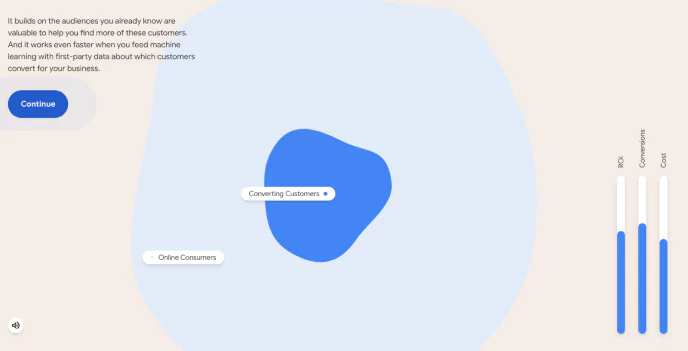
Where do you set up the Audience Signals on Google Ads?
Audience signals are set up in performance max campaigns, display ad campaigns, video campaigns, and discovery campaigns. In addition to this, Google Ads’ algorithm uses audience signals in all automated bidding strategies even if you do not give them specifically under the audience signals option.
Layering the audience signals and narrowing down things for the algorithm is a recommended approach. It is like going broad at the top & narrowing it down.
Targeting Website Visitors
Website visitors are a huge treasure that offers high-quality audience signals. Collect all the website visitor data and sync it with Google Ads. Now Google will retarget those audiences using the audience signals you have provided.
Google’s internal experiments have proved that ‘website visitors are the most valuable users’. Therefore target those website visitors to get the most out of them.
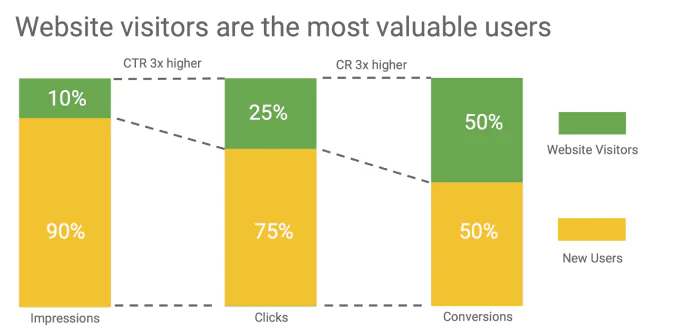
Caution: Lack of proper understanding of your website visitors ends up spending a huge amount of money on your Google Ads without many conversions. Therefore, segment your audience properly using either a 1PD Ops or Google Analytics. Understand and then sync that data with Google Ads to send the correct signals.
How to set up Audience Signals in PMax Campaign in Google Ads
When setting up a performance max campaign, finish with the bid strategy selection, and campaign settings. After that move on to the asset group. Give the URLs, ad creatives (both images & videos), logos, headlines, your business name, call to actions, prices, etc., to the ad platform. After you submit all the ad assets, you will find the audience signals at the end.
Click Create an audience signal in the performance max campaign. You will find the below screen.
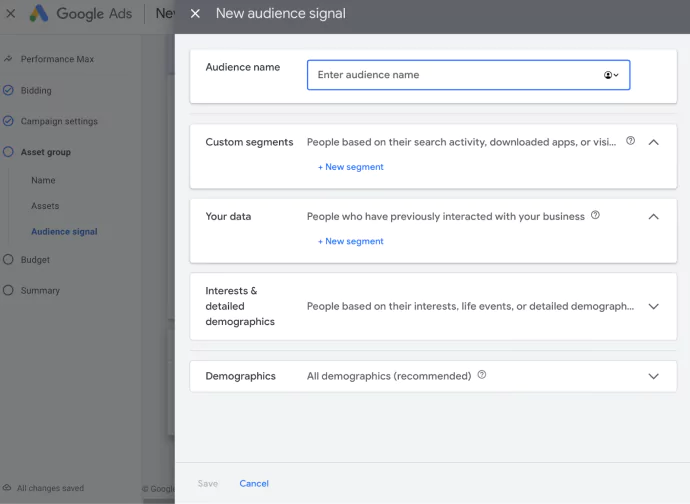
Enter the audience name (be as simple and clear as possible)
Using ‘your data’
This set of audiences was earlier termed ‘remarketing’. This is your website visitor data that you already possess. Create these audiences using the audience manager in order to use them here at the audience signal in PMax Campaign.
Types of ‘your data’ that are available to create a segment:
- Customer list
- Lead form segment
- YouTube users
- App users
- Website visitors
Here comes the major part of using your data effectively to provide those ‘right’ signals to the ad platform.
Collect your website visitor data, segment them ‘properly’, and then use them in the audience signals option while setting up the campaign to give those ‘right audience signals’.
Customers that are already aware of the brand are the high-intent audience. Adding customer data as audience signals will help the algorithm understand the traits of your purchasers and reach out to similar audiences.
The customer data can be segmented as below before you send it to Google Ads
- Added to cart but not purchased
- Added to wishlist
- Users with an average order value greater than $250
- Users with a lifetime value of more than $5000
Audience segmentation can be done based on your strategies. You can either go broad or narrow down your target.
Create custom segments
Click on +New Segment.
Next, out of the two options available choose one. Either go by people searching for relevant keywords or give the algorithm the interest of the ideal audience or purchase intents.
Choose the prompts for keywords / interests / purchase intentions that Google Ads gives after you type in relevant words. It shows the insights of the segment on the right. For example, we tried typing in red party wear dress and women’s fashion to select various prompts. Find the below screenshot to understand better.
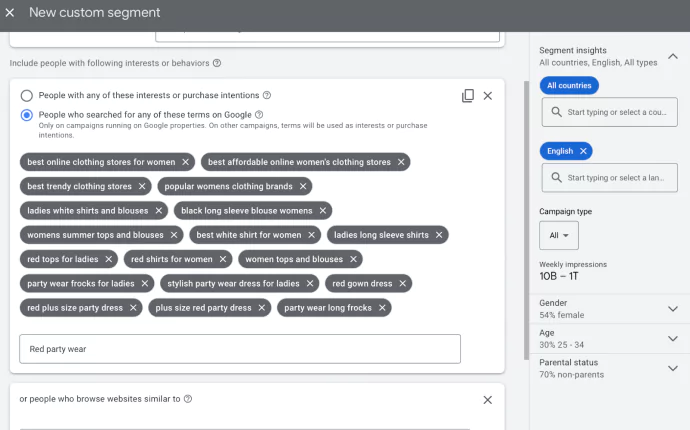
Hint the algorithm by providing URLs that your target audience is most likely to visit. To do so, use this option, and expand the segment to choose people who browse a certain type of website.
Tip: For an eCommerce company that is selling women’s fashion clothes, URLs of cosmetic companies like L’Oréal, footwear, and costly women’s accessories like Gucci, Prada, etc., are relevant. Providing these URLs lets the algorithm help it understand which audience is highly interested in your products.
Note: Additionally, input the Apps that you think your similar audience might be interested in.
Check the insights on the right and save to continue to go back to the screen of audience signals.
Interests & detailed demographics
The interests & detailed demographics help you personalize your ad to the user. With this audience signal the algorithm understands that users with the interests you have provided are high-intent users.
The below screenshot shows the available ways you can provide information such as detailed demographic information, in-market audience segments, affinity audience segments, and life events.
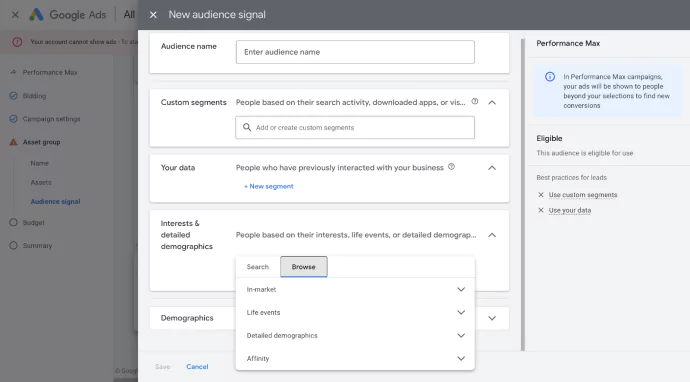
Based on the demographics such as age, gender & income, the algorithm understands who is the ideal audience for your ad campaign.
The Life event option allows you to target the audience by special events like birthday, marriage day, etc. This audience signal in PMax helps when the product is personalized to users based on their special days.
For example, a user with their birthday in December can be targeted with an ad showing ‘Get a special dress for your birthday’ to grab their attention and get more conversions. To do this, life event audience signals help.
In the interests & demographics, in-market & affinity audience options are available. Google Ads uses the information provided in the form of affinity audience & in-market audience to target the right audience.
The below screenshot from Google Ads shows how each and every in-market audience or affinity audience details are shown as soon as you hover over the audience segment.
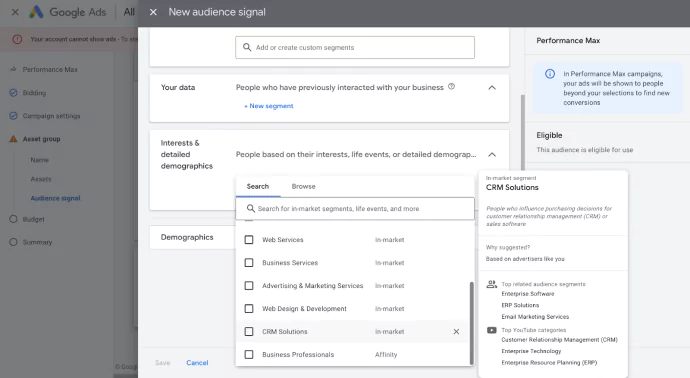
Giving detailed demographic information such as age, gender, parental status & income helps you target the right audience.
Using Google Analytics to Leverage Audience Signals
GA4 helps understand the audience using the data such as demographic patterns, user behavior, interests, language, demographic information such as age, & gender, device, conversion events, most performing landing pages, products purchased, and many more.
Using the data and patterns, analyze your audience behavior and conversions to know the audience better. This data helps you understand the audience and leverage the same to push the relevant, best-possible audience signals to the algorithm.
Benefits of Audience Signals in Google Ads
Google Ads considers the audience signals as the most valuable directions that the user is giving. Below are some of the benefits of audience signals in Google Ads
- Ad Platform understands which audience are most likely to engage with the ads i.e., high-intent audience.
- When you input the right Google audience signals for the right ad creatives you can hyper-personalize the experience for the users.
- Increase the probability of the user to interact with your ads
- All these will lead to the better performance of your ad campaign.
How all this actually works in the background is based on how well you understand your audience.
Understanding the audiences gives you insights and the pain points of the users.
Tweaking the algorithm based on this data with the right audience signals will get you higher conversions easily at a less cost.
Stay Ahead of the Curve
Based on your data and audience signals, the algorithm will build itself and enhance your ad campaign performance to stay ahead of the curve.
To conclude, it is evident why audience signals are important for the ad platform algorithm and why you as a digital marketer should know about them.
When you correctly leverage the full potential of the audience signals, you can
- Target the high-intent audience
- Personalize the ad experience
- Optimize your ad campaigns
- Increase conversion rate
- Enhance return on ad spend (ROAS).

